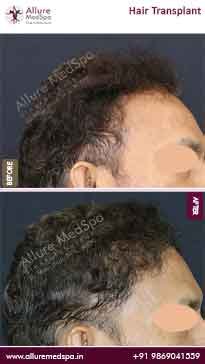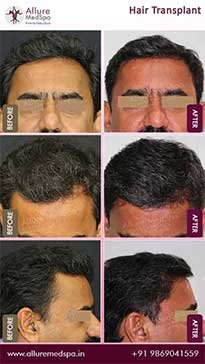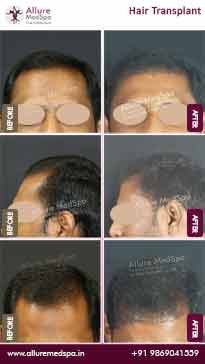Hair Fall Treatment in Mumbai – Safe, Effective & Visible Results
Is Hair Loss Taking a Toll on Your Confidence?
- Do you notice clumps of hair in the shower drain, on your pillow, or every time you comb?
- Is your hairline receding or your crown thinning, making you look older than you feel?
- Have you tried endless shampoos and serums, only to feel more frustrated?
Hair loss isn’t just about appearance—it hits your confidence, alters how you see yourself, and sometimes affects how others see you. Whether it’s a slow thinning across the scalp or a rapid retreat of the hairline, it can make even getting dressed or facing the mirror feel disheartening. For many, it’s not just cosmetic—it’s deeply emotional.
But there’s good news.
Modern Hair Loss Treatments offer a range of solutions—from non-surgical options like PRP therapy and mesotherapy, to advanced surgical techniques like hair transplant—all designed to restore not just your hair, but your self-assurance. With expert diagnosis and the right approach, you can stop hair loss in its tracks and encourage real, visible regrowth.
Global & Indian Insights (2023):
- Hair restoration procedures increased by 15.8% globally in 2023
- India ranked among the top 5 countries for hair transplant procedures
- Over 3 million people in India actively seek hair loss treatment annually
Source: ISAPS Global Survey 2023
What Is Hair Loss Treatment?
Hair Loss Treatment refers to a range of medical and aesthetic interventions aimed at controlling hair fall, restoring lost hair, and stimulating regrowth. It begins with an accurate diagnosis—distinguishing between temporary hair fall and permanent hair loss conditions like androgenetic alopecia.
Depending on the severity and cause, treatments may include:
- Non-surgical options: PRP (Platelet-Rich Plasma), mesotherapy, topical minoxidil, or oral finasteride
- Surgical solutions: Hair transplant via FUE (Follicular Unit Extraction) or FUT (Follicular Unit Transplant)
- Lifestyle & nutritional plans: To manage stress, deficiencies, and hormonal imbalances
Personalized treatment plans are key to getting natural-looking, lasting results—whether you’re facing early-stage thinning or advanced baldness.
Synonyms for Hair Loss Treatment:
Hair Restoration Therapy, Hair Regrowth Treatment, Hair Thinning Solution, Anti-Hair Loss Therapy, Hair Revitalization Treatment, Scalp Rejuvenation Therapy, Alopecia Management, Baldness Treatment, Hair Fall Control Program, Non-Surgical Hair Recovery
“Is this the right time to treat your hair loss?”
Hair Loss Treatment Before and After Images
Hair Loss Treatment Testimonials: Fine To Fabulous Journeys
Awarded by Google.com
Rating: 4.7
Reviews: 485+
Awarded by WhatClinic.com
Rating: 4.8
Reviews: 119+
Awarded by Realself
Rating: 4.9
Reviews:453+
Awarded by Facebook
Rating: 4.6
Reviews:105+
What Causes Hair Loss Other Than Genetics?
Hair loss isn’t always hereditary. Autoimmune disorders, stress, poor nutrition, or hormonal changes can also disrupt the hair growth cycle and trigger shedding.
Common Non-Genetic Causes of Hair Loss:
- Alopecia Areata: Autoimmune condition causing patchy baldness
- Telogen Effluvium: Stress, illness, or hormonal shifts push hair into shedding phase
- Anagen Effluvium: Hair loss during growth phase, often from chemo or toxins
- Scalp Psoriasis: Inflammatory condition with itchy, scaly patches
- Seborrhoeic Dermatitis: Dandruff-related scalp inflammation that impacts follicles
- Trichotillomania: Stress-related hair-pulling disorder
- Poor Diet or Sudden Weight Loss: Nutrient deficiencies (iron, biotin, protein)
- Hormonal Changes: Postpartum, menopause, thyroid disorders
- Certain Medications: Antidepressants, chemotherapy, blood pressure drugs
Diagnosis Options:
- Scalp biopsy
- Hair pull/wash test
- Blood tests for thyroid & iron levels
If you’re losing hair and unsure why, consult a dermatologist for a proper diagnosis and personalized treatment plan.
“Ask More About Hair Loss”
What Is Male Pattern Baldness and Why Does It Happen?
Male pattern baldness, or androgenic alopecia, is a genetic condition where DHT shrinks hair follicles, leading to progressive, patterned hair loss in men.
Key Facts About Male Pattern Baldness:
- Cause: Genetic sensitivity to DHT (dihydrotestosterone)
- Medical Term: Androgenic alopecia
- Onset Rate:
- 20% affected by age 20
- 50% by age 50
- 80% have family history of baldness
- Hormonal Mechanism: Testosterone → (via 5-alpha reductase) → DHT → follicle shrinkage
- Affected Areas: Frontal hairline, crown, mid-scalp
- Resistant Zones: Back & sides of scalp (safe donor zone)
What Are the Symptoms of Male Pattern Baldness?
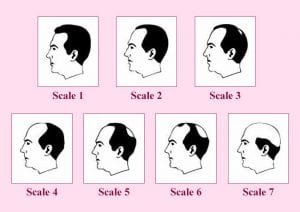
- Receding hairline forming an “M” shape
- Thinning crown or mid-scalp bald patches
- Gradual reduction in hair density
- Complete baldness in advanced stages (Norwood Scale)
What Worsens Male Baldness?
- Stress, smoking, nutritional deficiency
- Medical issues (thyroid, anemia, diabetes)
- Medications and harsh hairstyles
- Family history (maternal or paternal)
Can Male Pattern Baldness Be Treated?
Permanent solution:
- Hair Transplant – FUE or FUT techniques to restore hair with natural results
Non-surgical treatments:
- PRP therapy
- Mesotherapy
- Hair growth medications
“Ask More About Hair Loss”
What Is Female Pattern Hair Loss and How Can You Identify It?
Female pattern hair loss is a genetic condition that causes progressive thinning and widening of the hair part—often visible as a Christmas-tree pattern on the scalp.
Early Signs of Female Pattern Baldness
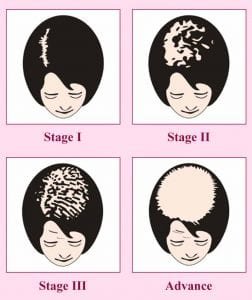
- Noticeable hair thinning over the crown
- Widening of the central hair partition
- Excess hair fall (100+ strands daily)
- Reduced ponytail volume
- Gradual scalp visibility (Ludwig Scale grades)
What Causes Female Pattern Hair Loss?
- Genetics (family history of hair loss)
- Hormonal changes (menopause, PCOD, thyroid issues)
- Nutritional deficiencies (iron, biotin, vitamin D)
- Stress or chronic illness
- Overuse of chemical salon treatments (rebonding, coloring)
- Certain medications (antidepressants, anti-hypertensives)
Quick Facts About Female Pattern Hair Loss

- Affects 40% of women by age 50
- Most common hair loss type in women
- Progresses gradually over years
- Treated with PRP, minoxidil, mesotherapy, or hair transplant (in advanced cases)
- Diagnosed using Ludwig Scale or dermatoscope
“Ask More About Hair Loss”
What Is Scarring Alopecia and How Does It Cause Permanent Hair Loss?
Scarring alopecia is a rare, inflammation-driven hair loss condition that permanently destroys hair follicles and replaces them with scar tissue.
- Affects: ~3% of hair loss patients (both men & women)
- Caused by: Inflammation from trauma, burns, infection, or autoimmune response
- What Happens:
- Oil glands & stem cells are damaged
- Follicles are replaced with fibrous scar tissue
- Hair loss becomes irreversible
- Symptoms: Redness, burning, itching, scaling
- Progression: Can be slow or rapid
- Treatment Tip: Hair transplant is possible after inflammation is fully controlled with immunosuppressants or anti-inflammatory therapies.
What Are the Treatment Options for Telogen Effluvium Hair Loss?
Telogen effluvium is reversible. Once the trigger—like stress or deficiency—is removed, targeted treatments help restore healthy hair growth.
Treatment Options Include:
i. Correcting Nutritional Deficiencies
- Supplements with protein, B-vitamins, iron, and zinc
- Diet planning to restore hair-friendly nutrients
ii. Non-Surgical Hair Replacement
- Custom-designed natural hair systems using real human hair
- Ideal for temporary yet realistic coverage
iii. Hormonal Therapy (if needed)
- Estrogen and progesterone pills or creams
- For hormone-related telogen effluvium (especially post-pregnancy or menopause)
iv. Stress Management
- Counseling or therapy to reduce chronic stress
- Yoga, mindfulness, and sleep regulation aid recovery
v. Expert Dermatologist Consultation
- Personalized care based on medical history, lab tests, and scalp assessment
- Combines therapies for faster regrowth
Tip: Don’t ignore sudden hair shedding—early intervention ensures full recovery.
“Ask More About Hair Loss"
What Are the Common Effects of Dandruff on Hair and Scalp?
Dandruff can lead to hair fall, dryness, and itchiness. It affects self-esteem and worsens during weather changes, especially in monsoon or winter.
Signs of Dandruff
- White or yellow scalp flakes
- Itchy or red scalp
- Hair looks dry, dull, or frizzy
- Can appear on eyebrows, ears, or chest
- Reduced confidence and social discomfort
Tip: Treat dandruff early to prevent scalp inflammation and hair thinning.
What Is Scalp Psoriasis and How Does It Affect Hair?
Scalp psoriasis is an autoimmune disorder that causes thick, scaly patches and hair loss due to rapid skin cell turnover and chronic inflammation.
Symptoms and Causes
- Red, scaly, itchy patches on scalp or near ears
- Thick flakes that resemble dandruff
- May cause temporary hair loss due to scratching
- Triggered by stress, cold weather, or certain medications
- Diagnosed with a scalp biopsy
Note: It’s not contagious but needs medical treatment for long-term control.
How Can Diet and Nutrition Help Prevent Hair Loss Naturally?
A balanced, nutrient-rich diet supports healthy hair growth and helps reduce hair fall by strengthening hair follicles and improving scalp health.
Key Nutrients to Prevent Hair Fall
- Protein – Builds keratin for strong hair
Sources: Eggs, fish, soybeans, nuts, pulses, dairy - Biotin & B-Vitamins – Prevent brittleness and hair thinning
Sources: Whole grains, legumes, leafy greens, eggs - Iron – Improves oxygen supply to follicles
Sources: Spinach, lentils, raisins, poultry, apples - Vitamin A – Boosts sebum production and scalp moisture
Sources: Carrots, sweet potatoes, mangoes, pumpkin - Zinc – Helps hair follicle function and reduces dandruff
Sources: Sunflower seeds, dairy, legumes, meats, cereals
Pro Tip: Crash diets, skipping meals, or excessive sugar can worsen hair loss. Eat smart, not just topical care!
How Can You Prevent Hair Loss Naturally?
Preventing hair loss starts with gentle care, avoiding harsh chemicals, and protecting your scalp. Small daily habits can make a big difference.
Hair Care Tips to Reduce Hair Fall:
- Use a wide-toothed comb to prevent breakage
- Avoid chemical treatments like rebonding or excessive coloring
- Be cautious with medications that may trigger hair fall (consult your doctor)
- Cover your head in harsh sunlight or while riding a bike
- Quit smoking—it restricts blood flow to hair follicles and accelerates baldness
Pro tip: A balanced diet rich in protein, iron, and vitamins also supports healthy hair growth.
“Ask More About Hair Loss”
Can Natural Hair Regrowth Be Achieved with or without Surgery?
Yes! Natural hair regrowth is possible through hair transplantation or therapies like PRP and mesotherapy, depending on hair loss type and severity.
Surgical Hair Regrowth Methods
1. FUT Hair Transplant (Strip Method)
- A strip of scalp from the back is removed
- Grafts are dissected under magnification
- Implanted into balding areas
- Suitable for advanced baldness cases
- Leaves a linear scar (easily hidden)
2. FUE Hair Transplant (Follicular Unit Extraction)
- Individual grafts extracted using punch tools
- No visible scarring; faster healing
- Ideal for those seeking minimally invasive options
Non-Surgical Hair Growth Therapies
1. PRP Therapy (Platelet-Rich Plasma)
- Uses patient’s own blood
- Platelets separated and injected into scalp
- Stimulates dormant follicles and improves thickness
2. Mesotherapy
- Microinjections of vitamins, enzymes, and plant extracts
- Enhances scalp circulation and nutrient delivery
- Encourages natural hair regrowth
Expert Tip: Combine PRP or mesotherapy with surgical options for enhanced results.
“Ask More About Hair Loss”
What Happens During a Hair Loss Diagnosis and Consultation?
A hair loss consultation includes medical evaluation, scalp analysis, and a personalized treatment plan to identify the cause and outline the best solution.
1. Medical Assessment
- Detailed history of hair loss, lifestyle, genetics, and triggers
- Review of past treatments or medications
- Evaluation of hair loss pattern (diffuse, patchy, frontal, etc.)
2. Scientific Scalp Analysis
- A video microscope magnifies the scalp up to 200x
- Assesses follicle health, scalp condition, and hair density
- Helps differentiate between types of alopecia (e.g., androgenic vs. telogen effluvium)
3. Customized Treatment Plan
- Developed by board-certified dermatologists with trichology expertise
- May include nutritional advice, topical therapies, PRP, medications, or hair transplant
- Integrated cosmetic and medical approach for best outcomes
Tip: Early diagnosis leads to better control and reversal of hair fall. Book your expert consultation at Allure Medspa today!
“Ask More About Hair Loss”
What Is the Cost of Hair Loss Treatment in Mumbai?
Hair loss treatment cost depends on the chosen method. PRP starts from ₹5,000/session, while hair transplant costs vary based on technique and grafts.
Average Cost Breakdown:
- PRP Therapy: ₹5,000 – ₹7,000 per session
- Mesotherapy: ₹3,000 – ₹6,000 per session
- FUT Hair Transplant: ₹25 – ₹40 per graft
- FUE Hair Transplant: ₹30 – ₹60 per graft
- Total Hair Transplant Cost (2,000–3,000 grafts): ₹60,000 – ₹1,80,000
Note: Costs may vary based on clinic reputation, surgeon’s expertise, and technology used.
Is it worth the investment? Yes—when done by a certified hair restoration expert, results are long-lasting and natural-looking.
“Want a personalized estimate? to get accurate pricing and treatment guidance.”
(FAQs) Frequently Asked Question about Hair Loss Treatment
Q1. Which treatment is best for hair loss?
The most effective treatments include PRP therapy, Minoxidil, Finasteride (for men), and hair transplant. A dermatologist can recommend the best option based on your hair type and cause of hair loss.
Q2. How can I regrow my hair naturally?
You can encourage natural regrowth through scalp massage, biotin-rich oils, a protein- and iron-rich diet, and by avoiding heat and chemical damage.
Q3. What is the Big 3 hair loss treatment?
The “Big 3” includes Minoxidil (topical), Finasteride (oral, for men), and Ketoconazole shampoo. These are clinically backed for androgenic alopecia.
Q4. What to eat to reduce hair fall?
Include eggs, leafy greens, nuts, seeds, lentils, and citrus fruits. Focus on protein, iron, biotin, zinc, and vitamins A, C, D, and E.
Q5. Which vitamin is good to stop hair fall?
Biotin, Vitamin D, B12, Iron, and Zinc are essential for hair strength and growth. Deficiencies in these can trigger shedding.
Q6. Is there a permanent cure for hair loss?
While some causes like nutritional or stress-related hair loss are reversible, genetic hair loss requires ongoing treatment or hair transplant for long-term correction.
Q7. Why am I losing so much hair suddenly?
It could be due to stress, illness, post-COVID effects, hormonal imbalance, or nutritional deficiencies. A blood test can help identify the cause.
Q8. Can stress cause hair fall?
Yes. Emotional or physical stress can trigger a condition called telogen effluvium, causing excessive shedding for 2–3 months after the stress event.
Q9. How much hair fall is considered normal?
Losing 50–100 strands per day is normal. If you notice clumps or visible scalp patches, it’s best to consult a dermatologist.
Q10. What is the best oil for hair growth?
Coconut, castor, rosemary, and argan oil are great for nourishing the scalp and stimulating hair growth.
Q11. How to grow hair faster?
Improve scalp circulation through massage, eat protein-rich food, use biotin-based products, and avoid heat styling and chemical treatments.
Q12. How to stop hormonal hair loss?
Consult a doctor to balance hormone levels. Treatments may include anti-androgens, DHT blockers, or PRP therapy depending on the diagnosis.
Q13. How to hide thinning hair?
Use volumizing powders, root sprays, fiber concealers, or get scalp micropigmentation. A shorter, layered haircut can also reduce visible thinning.
Q14. Is balding at 25 normal?
Yes, if it’s genetic (androgenic alopecia). Early signs at 20s are common, especially in men. Treatment works best when started early.
Q15. How to care for thin or weak hair?
Use gentle, sulfate-free shampoos, avoid tight hairstyles, limit heat, and regularly condition ends. Choose lightweight products that don’t weigh hair down.
Medical Codes for Hair Loss Treatment
CPT Code and Description for Hair Loss Treatment
| CPT Code | CPT Description | ICD-10 Code |
|---|---|---|
| 20926 | Tissue grafts, other (e.g., fat grafts used for hair restoration) | L64 |
| 0232T | Injection(s), platelet-rich plasma, any site, including image guidance when performed | L64 |
| S0600 | Scalp Micropigmentation | L64 |
Related Links
Note: The author of this content is Dr. Milan Doshi, An Indian board-certified plastic & cosmetic Surgeon wholly & solely confirms the authenticity of the information & knowledge delivered by this write-up.


